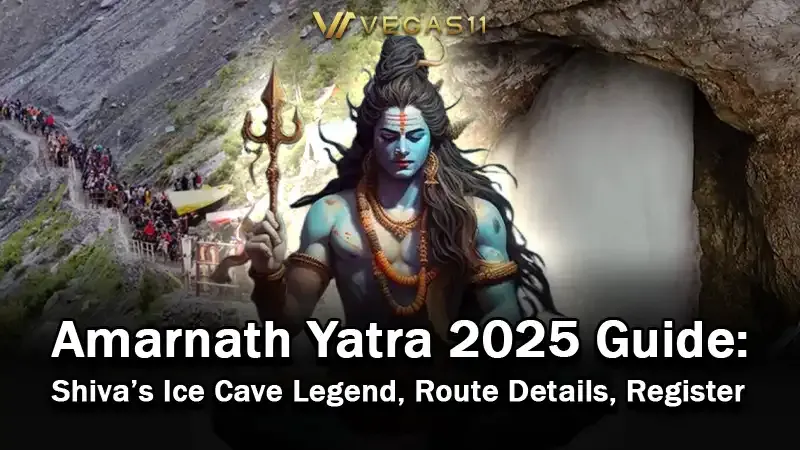
Bro, ready for a spiritual adventure with Mahadev? The Amarnath Yatra 2025 (July 3 – August 9) takes you through the Himalayas to worship the mystical Ice Lingam!
Wanna uncover the secrets of the holy cave? Or choose the best route? I’ve got it all sorted for you! Plus, I’ll walk you through the registration steps too — scroll down and let’s start this blessed journey of Shiva together!
Around 5,000 years ago, it’s said that Lord Shiva decided to reveal the “Secret of Immortality” (Amar Katha) to his wife, Goddess Parvati.
Shiva chose an ultra-hidden spot to share this divine knowledge — a cave located at an altitude of 3,888 meters in today’s Himalayas, now known as the Amarnath Cave.
To ensure no one else could overhear, Shiva left no room for mistakes:
He stationed his bull Nandi at the cave’s entrance, ordered Vasuki, the king of snakes, to guard the path, had Ganesha, his elephant-headed son, stand watch around the area, and even made the moon and sun vanish temporarily — all to prevent any eavesdropping!
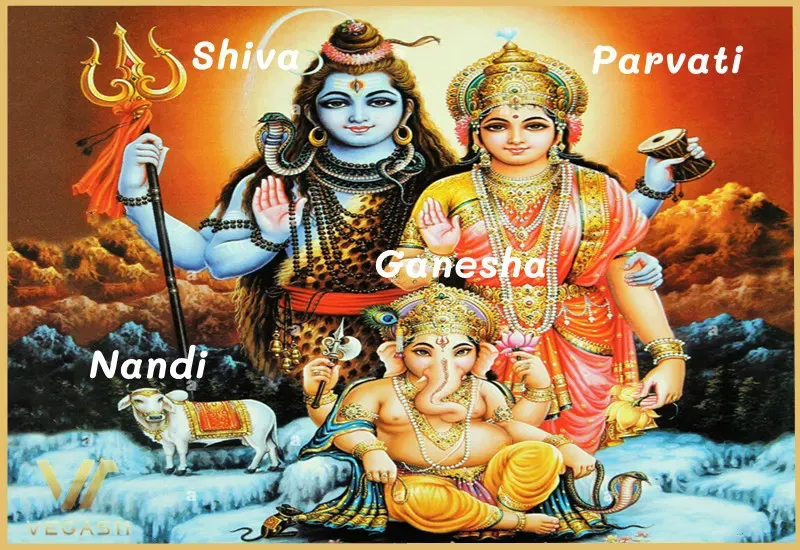
But here’s the twist — as Shiva began revealing the secret, Parvati actually fell asleep. However, a pair of pigeons inside the cave stayed awake and heard the whole thing. As a result, they were blessed with eternal life.
Even today, it’s believed that spotting that pair of pigeons during the Yatra is an ultra-lucky omen 🕊️.
Inside the cave lies the awe-inspiring Ice Lingam, a natural ice stalagmite that symbolizes Shiva. Beside it, two smaller ice formations represent Parvati and Ganesha.
This natural wonder is seen as both a miracle of nature and a powerful manifestation of Shiva’s divine energy.
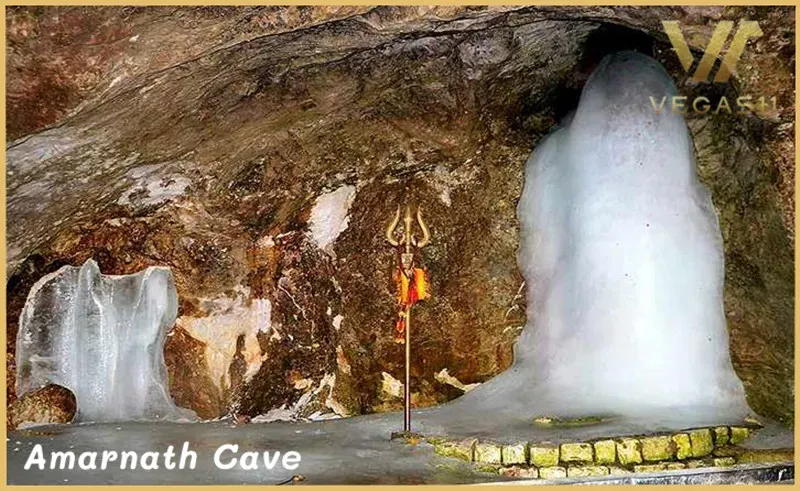
One of Hinduism’s Four Great Holy Sites, it is believed that Lord Shiva revealed the "Path to Immortality" to Goddess Parvati here.
The naturally formed Ice Lingam inside the cave is seen as a sacred manifestation of Shiva, drawing countless pilgrims every year.
Legend says it was discovered in the 15th century by a shepherd named Butta Malik.
He encountered a saint who gave him a bag of coal. When he returned home, the coal had turned into gold!
When he went back to find the saint, he only found the holy cave. Since then, the cave has become a revered pilgrimage site.
While Shiva was revealing the secret of immortality, two pigeons were hiding and listening. As a result, they were granted eternal life. Even today, some pilgrims claim to have seen this sacred pair of pigeons!
Amarnath is ranked among the top 10 highest-altitude religious caves in the world, sitting at an impressive 3,888 meters above sea level.
Every summer, a massive natural ice stalagmite forms inside the cave — a phenomenon that devotees believe to be Shiva’s body manifested through ice, also known as the sacred Shivlinga.
This divine ice formation only appears between June and August each year, drawing pilgrims from across the globe to witness and worship this miracle of nature.
There are three ways to reach Amarnath: Two trekking routes — Baltal and Pahalgam — and a more luxurious option: traveling by helicopter.
Most pilgrims choose to trek from Pahalgam on the way to the cave and return via Baltal, allowing them to experience the full spiritual journey while saving time and energy on the way back.
Regardless of the route you choose, a registration fee of ₹220 is required.
If you opt for the helicopter, an additional fee applies, typically ranging between ₹2,000 and ₹5,000 per person.

The Baltal route is shorter, covering around 14–16 kilometers round trip, and can typically be completed within a single day.
However, the trail is much steeper and more challenging, making it ideal for those seeking a more intense trekking experience.
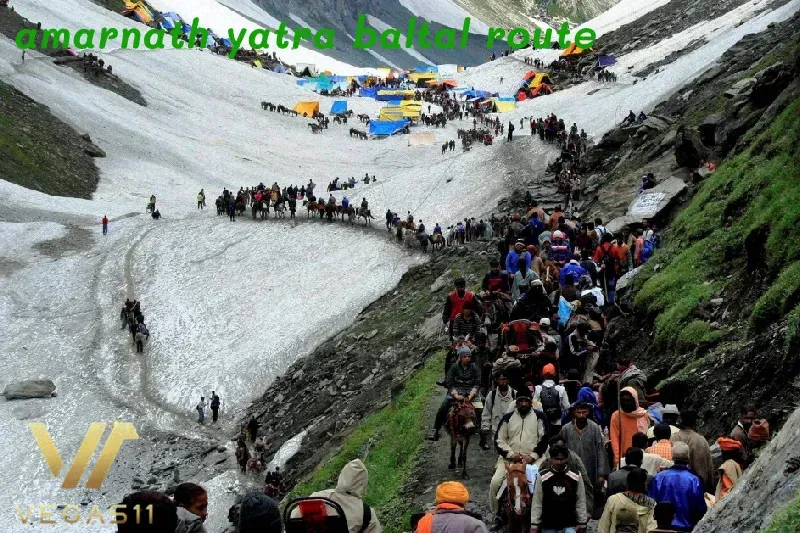
Starting from Pahalgam, this route passes through Chandanwari, Sheshnag, and Panchtarni before reaching the Amarnath Cave. The total distance is approximately 32–48 kilometers one way.
While longer, this route has a gentler slope, making it a better choice for elderly pilgrims and first-time trekkers. It’s also considered the most scenic route, offering breathtaking views along the way.
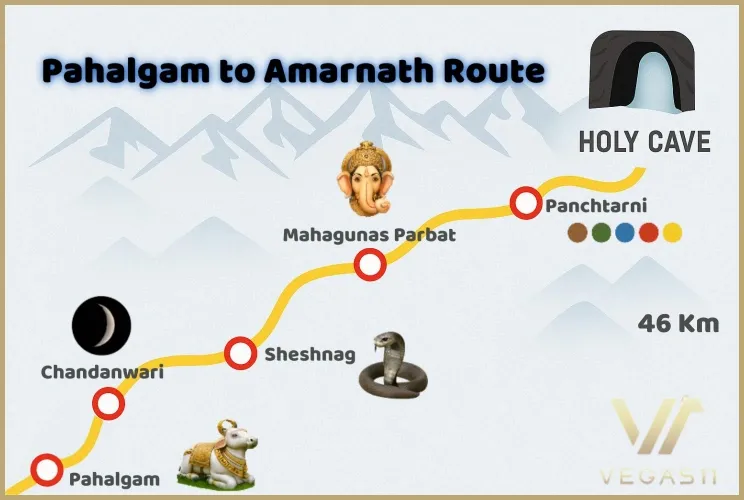
If you’re short on time or unable to undertake a long trek, you can opt to take a helicopter from either Pahalgam or Baltal to Panjtarni (about 6 kilometers from the Amarnath Cave).
From Panjtarni, you’ll need to walk or ride a horse to reach the cave.
Important: Helicopters cannot land directly at the cave, so the final 6 KM must be covered on foot or horseback.

There are two main routes to reach the Holy Amarnath Cave — the Baltal Route and the Pahalgam Route.
Here’s the quick verdict:

If you prefer a lighter way to complete your darshan, you can take a helicopter to Panchtarni and walk just 6 km from there.
👉 Long Yatra ahead? Take a chill break at Vegas11 — thoda fun bhi zaroori hai.
There are two ways to register for the Amarnath Yatra 2025:
Registration opens on April 14, 2025; Registration fee: ₹220 (includes the Yatra Permit and RFID tracking card)
The Yatra officially begins on July 3, 2025, and ends on August 9, 2025, lasting a total of 38 days.
Costs Vary Based on Route, Transportation, and Accommodation
Pilgrims can check the official website for the recommended price ranges for 2025 to avoid being overcharged or scammed.
Important: Only postpaid SIM cards work along the Yatra route.
It’s recommended to use BSNL or Jio for the most stable network coverage.
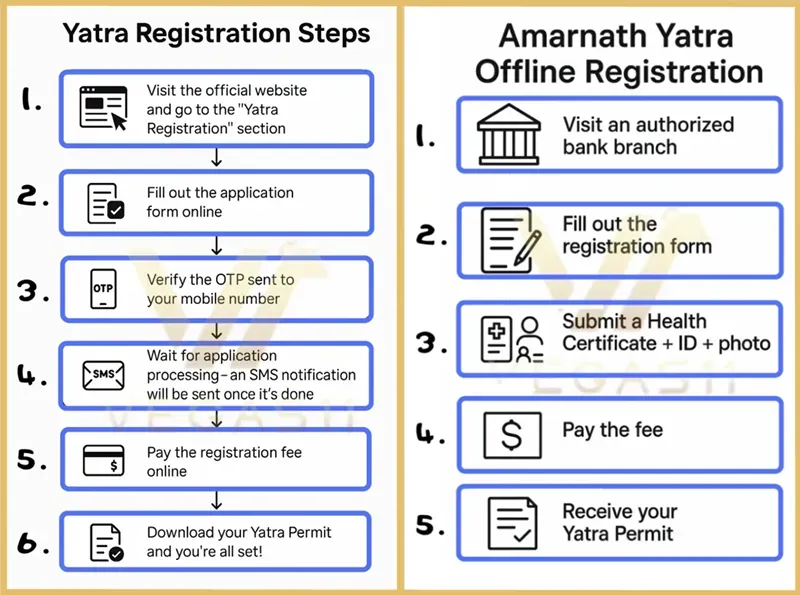
Ready for the holy trip to Baba Barfani’s darshan? Whether you’re a first-timer or a regular Yatri, getting your registration sorted is step number one before hitting the mountain trail!
Their story actually began in a previous life. Back then, she was Sati, who fell deeply in love with Shiva, even though her father disapproved of him.
For Shiva, she made the ultimate sacrifice — she chose to self-immolate.
Shiva carried Sati’s body on his shoulders and began his sorrowful Tandava — a cosmic dance so powerful that it shook mountains and rivers, almost tearing the universe apart.
It was only when Vishnu intervened, scattering Sati’s body into fragments across the land, that Shiva finally came to a stop.
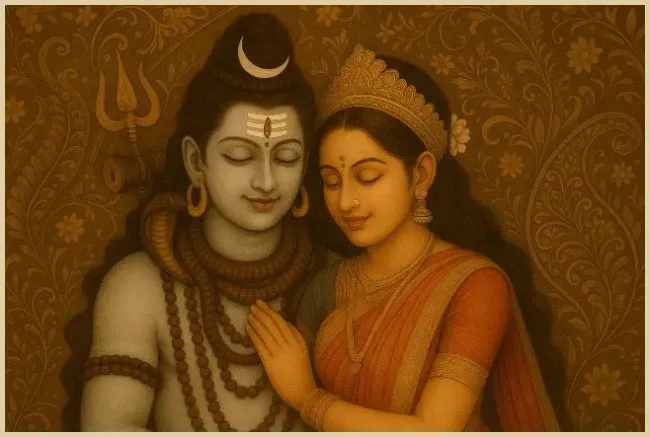
In her next life, she was reborn as Parvati. This time, she devoted herself to years of deep meditation and penance, hoping Shiva would finally recognize her. Her love never faded. (Ugh, my heart. May this kind of love knock me out cold )
At the end, they found their way back to each other. From that moment on, they were no longer two separate beings. Parvati stepped into Shiva’s world, and Shiva, at last, understood what it truly meant to love.
Legend has it that it was inside the Amarnath Cave that Shiva whispered to her the deepest secrets of the universe.
Thus, this pilgrimage is not just a journey to a sacred site — it’s a journey back to the very source of love and faith.
📌 Up next: Important pilgrimage tips — slow down, breathe deep, and set off on your sacred journey.
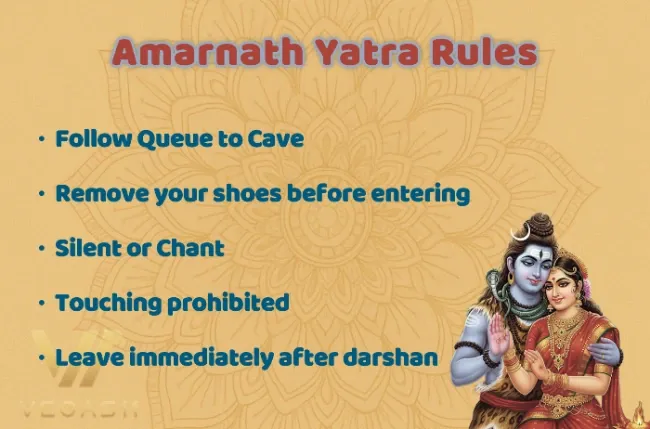
Curious about the story of Shiva's son? Further reading here: Ganesha’s Guide to Good Luck: Stories, Festivals, and Miracles!
These 12 Temples Are Where Shiva Manifested as Divine Light (Jyoti) Known as the Jyotirlingas, these 12 sacred temples are where Lord Shiva is believed to have appeared in the form of radiant light (Jyoti).
Spread across various parts of India, each Jyotirlinga represents a different aspect of Shiva’s immense power.
Further Reading: Lakshmi – The Divine Symbol of Wealth, Prosperity & Fortune
The Shakti Peethas mark the sacred spots where pieces of Goddess Sati’s body fell after being scattered by Lord Vishnu. Each site represents a unique expression of Shakti’s divine feminine energy.
There are over 40 Shakti Peethas within India, with others located in Pakistan, Nepal, Bangladesh, and nearby regions.
Every Shakti Peetha is associated with two deities:
| Shakti Peetha | Location | Legendary Body Part |
|---|---|---|
| Kamakhya | Assam | Womb |
| Kalighat | West Bengal | Right Toe |
| Vaishno Devi | Jammu & Kashmir | Palm |
| Jwalaji | Himachal Pradesh | Tongue |
| Ambaji | Gujarat | Heart |
| Mahalakshmi (Kolhapur) | Maharashtra | Eyes |
© 2025 Vegas11 Official Blog